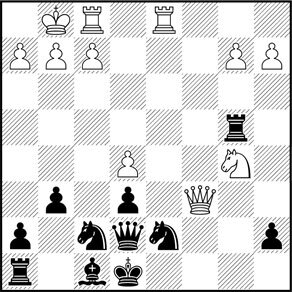A Chess-Position Memory Test (from Adriaan de Groot)
June 2, 2009 • By Eliot Hearst
(Please don’t peek at the diagram, located quite far below our introductory words, until you have read the commentary. It will spoil your fun!)
Adriaan de Groot (1914-2006), often considered the “father of chess psychology”, was a pioneer in developing methods for studying the important factors in chess skill. His work in the 1930’s and 40’s was a major inspiration for the work of later psychologists who investigated pattern recognition, memory, calculation, experience, and other aspects of the ability to play chess well or badly. One method that he used in his research was to present players of varying skills with a position for just a few seconds and then to remove it from sight and ask his subjects to reproduce the entire position about 30 seconds later. Details, results, and conclusions of these studies, as well as several subsequent ones by other experimenters starting in the 1970’s, are described in our book (Part II : The Psychology of Blindfold Chess).
Here is one of de Groot’s test positions for you to test yourself on. The subjects who had to recall this position after viewing it briefly and then being asked to reconstruct it about a half-minute later included a grandmaster (Max Euwe), a weak master (deGroot himself!), an expert player, and an average player. Although he used only these four subjects, the general results he obtained have been repeated many times by subsequent experimenters in the course of doing different kinds of research. There are 22 pieces in this position and his scoring of their performance was based mainly on how many pieces were placed correctly after the intervening period during which the pieces had been removed from sight. Euwe recalled all the pieces and the correct squares on which they had been located (100%: score of 22), de Groot (score of 21), the expert (score of 16), and the average player (score of 9). Thus the ability to recall this position, as well as many others tested, depended greatly on the strength of the player, a result that has been repeated many times afterwards in a variety of studies examining different factors involved in chess skill.
Perhaps the most interesting result from this type of test situation is how well grandmasters can perform; most of them reconstruct quite complicated positions with virtually no errors after their brief exposure.
[Scroll down to see the diagram: Please prepare before viewing the diagram by arranging an empty board some distance from your computer with pieces ready to set up 30 sec after you study the diagram for 5-10 seconds. Reconstruct the diagrammed position on this board as accurately as you can to compare yourself to master and expert performance]
